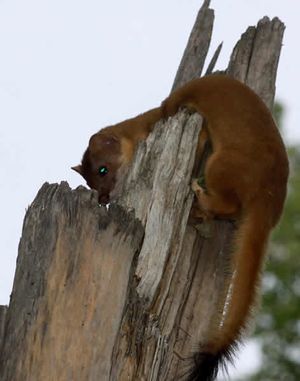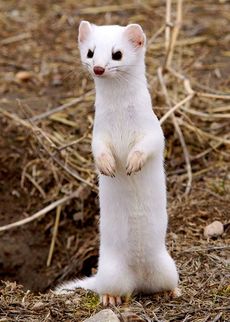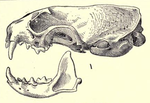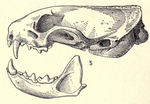ابن عرس طويل الذيل
| Long-tailed weasel | |
|---|---|

| |
| التصنيف العلمي | |
| مملكة: | |
| Phylum: | |
| Class: | |
| Order: | |
| Family: | |
| Subfamily: | |
| Genus: | |
| Species: | M. frenata
|
| Binomial name | |
| Mustela frenata Lichtenstein, 1831
| |

| |
| Long-tailed weasel range | |
ابن عرس طويل الذيل (long-tailed weasel ؛ Mustela frenata)، ويُعرف أيضاً بإسم ابن عرس الملجـَّم أو القاقم الكبير، هو نوع من mustelid يتوزع من جنوب كندا وفي جميع أرجاء الولايات المتحدة والمكسيك, southward through all of Central America and into northern South America. It is distinct from the short-tailed weasel, also known as a "stoat", a close relation which originated in Eurasia and crossed into North America some half million years ago.
التطور
The long-tailed weasel is the product of a process begun 5–7 million years ago, when northern forests were replaced by open grassland, thus prompting an explosive evolution of small, burrowing rodents. The long-tailed weasel's ancestors were larger than the current form, and underwent a reduction in size to exploit the new food source. The long-tailed weasel arose in North America 2 million years ago, shortly before the stoat evolved as its mirror image in Eurasia. The species thrived during the Ice Age, as its small size and long body allowed it to easily operate beneath snow, as well as hunt in burrows. The long-tailed weasel and the stoat remained separated until half a million years ago, when falling sea levels exposed the Bering land bridge, thus allowing the stoat to cross into North America. However, unlike the latter species, the long-tailed weasel never crossed the land bridge, and did not spread into Eurasia.[2]
الوصف
 ابن عرس طويل الذيل في معطفه الشتائي |
 ابن عرس أصغر في معطفه الشتائي. |
السلوك
الغذاء

The long-tailed weasel is a fearless and aggressive hunter which may attack animals far larger than itself. When stalking, it waves its head from side to side in order to pick up the scent of its prey. It hunts small prey, such as mice, by rushing at them and kills them with one bite to the head. With large prey, such as rabbits, the long-tailed weasel strikes quickly, taking its prey off guard. It grabs the nearest part of the animal and climbs upon its body, maintaining its hold with its feet. The long-tailed weasel then manoeuvres itself to inflict a lethal bite to the neck.[3]
The long-tailed weasel is an obligate carnivore which prefers its prey to be fresh or alive, eating only the carrion stored within its burrows. Rodents are almost exclusively taken when they are available. Its primary prey consists of mice, rats, squirrels, chipmunks, shrews, moles and rabbits. Occasionally, it may eat small birds, bird eggs, reptiles, amphibians, fish, earthworms and some insects. The species has also been observed to take bats from nursery colonies. It occasionally surplus kills, usually in spring when the kits are being fed, and again in autumn. Some of the surplus kills may be cached, but are usually left uneaten. Kits in captivity eat from ¼–½ of their body weight in 24 hours, while adults eat only one fifth to one third. After killing its prey, the long-tailed weasel laps up the blood, but does not suck it, as is popularly believed. With small prey, also the fur, feathers, flesh and bones are consumed, but only some flesh is eaten from large prey. When stealing eggs, the long-tailed weasel removes each egg from its nest one at a time, then carries it in its mouth to a safe location where it bites off the top and licks out the contents or if they have babies in the den they may hold it in their mouth all the way back to them.[3]
تحت الأصناف
اعتبارا من 2005[تحديث],[4] ثمة 42 نوع فرعي تم التعرف عليهم.
| أظهرالنوع الفرعي | Trinomial authority | الوصف | النطاق | المرادفات |
|---|
الهامش
ملاحظات
- ^ {{{assessors}}} (2008). Mustela frenata. القائمة الحمراء للأنواع المهددة بالانقراض 2008. IUCN سنة 2008. تم استرجاعها في 29 March 2010. Database entry includes a brief justification of why this species is of least concern
- ^ Macdonald 1992, p. 205
- ^ أ ب Schwartz & Schwartz 2001, pp. 306–307
- ^ Wozencraft, W. C. (16 November 2005). Wilson, D. E., and Reeder, D. M. (eds) (ed.). Mammal Species of the World (3rd edition ed.). Johns Hopkins University Press. ISBN 0-801-88221-4.
{{cite book}}:|edition=has extra text (help);|editor=has generic name (help); Check date values in:|date=(help)CS1 maint: multiple names: editors list (link) - ^ Merriam 1896, pp. 26–28
- ^ Merriam 1896, pp. 31–32
- ^ Merriam 1896, p. 24
- ^ Merriam 1896, pp. 22–24
- ^ Merriam 1896, pp. 28–29
- ^ Merriam 1896, pp. 29–30
- ^ Merriam 1896, pp. 20–21
- ^ Merriam 1896, pp. 16–18
- ^ أ ب Merriam 1896, pp. 25–26
- ^ Merriam 1896, p. 19
- ^ Merriam 1896, pp. 21–22
- ^ Merriam 1896, p. 21
- ^ Merriam 1896, pp. 30–31
- ^ Merriam 1896, pp. 18–19
ببليوگرافيا
- Coues, Elliott (1877). "Fur-bearing Animals: A Monograph of North American Mustelidae". Government Printing Office.
{{cite journal}}: Cite journal requires|journal=(help); Invalid|ref=harv(help) - Feldhamer, George A.; Thompson, Bruce Carlyle; Chapman, Joseph A. (2003). "Wild mammals of North America: biology, management, and conservation". JHU Press. ISBN 0-8018-7416-5.
{{cite journal}}: Cite journal requires|journal=(help); Invalid|ref=harv(help) - Kurtén, Björn (1980). "Pleistocene mammals of North America". Columbia University Press. ISBN 0-231-03733-3.
{{cite journal}}: Cite journal requires|journal=(help); Invalid|ref=harv(help) - Macdonald, David (1992). "The Velvet Claw: A Natural History of the Carnivores". New York: Parkwest. ISBN 0-563-20844-9.
{{cite journal}}: Cite journal requires|journal=(help); Invalid|ref=harv(help) - Merriam, Clinton Hart (1896), Synopsis of the weasels of North America, Washington : Govt. Print. Off., https://archive.org/details/synopsisofweasel00merriala
- Merritt, Joseph Anne; Matinko, Ruth F. (1987), Guide to the mammals of Pennsylvania, University of Pittsburgh Press, ISBN 0-8229-5393-5
- Schwartz, Charles Walsh; Schwartz, Elizabeth Reeder (2001), The wild mammals of Missouri, University of Missouri Press, ISBN 0-8262-1359-6
وصلات خارجية
 Media related to Mustela frenata at Wikimedia Commons
Media related to Mustela frenata at Wikimedia Commons
- CS1 errors: generic name
- CS1 errors: extra text: edition
- أنواع القائمة الحمراء غير المهددة
- مقالات فيها عبارات متقادمة منذ 2005
- جميع المقالات التي فيها عبارات متقادمة
- Weasels
- Carnivorans of North America
- Carnivorans of Central America
- Carnivorans of South America
- ثدييات كندا
- ثدييات كولومبيا
- Mammals of Costa Rica
- Mammals of Ecuador
- Mammals of Mexico
- Mammals of Panama
- Mammals of Peru
- ثدييات الولايات المتحدة
- Mammals of Venezuela
- Least concern biota of North America
- Least concern biota of South America
- Mammals described in 1831





